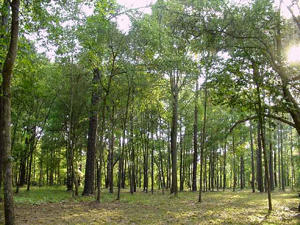– with deforestation rate less than 0.06 %
GUYANA is visionary pioneer in the area of climate mitigation, and has been applauded internationally for developing new and replicable models of ‘payment for forest services’ agreements, such as the MOU with the Kingdom of Norway which will see this country receiving approximately US$250M by 2015 for the carbon storage services of our forests.  Additionally, Guyana is now in the final stages of developing the World’s first
Additionally, Guyana is now in the final stages of developing the World’s first
national level Monitoring, Reporting and Verification (MRV) System which is fully IPCCC compliant.
And according to Minister of Natural Resources and the Environment, Mr. Robert Persaud, intensive work has also started on the valuation of the many other ecosystem services that Guyana’s forests have to offer the world.
“As Guyanese, we are fortunate to have been blessed with over 18 million hectares
of this precious, renewable natural resource. We are also united in the firm conviction that this resource must be used in an environmentally friendly manner for our socio-economic benefits,” Minister Persaud said in a message on the occasion of World Forestry Day 2012, which was observed yesterday.
This, he said, is borne out by several recent independent internationally accepted verifications and accuracy assessments which confirm that Guyana’s deforestation
rate is less than 0.06 %, even though multiple use forestry utilization activities have been on-going for centuries.
Following is the full text of the message by Minister Robert Persaud on the occasion of ‘WORLD FORESTRY DAY 2012’ which was observed yesterday:
WORLD Forestry Day had its origins conceptually at the 23rd General Assembly
of the European Confederation of Agriculture in 1971; later that year, the United Nations Food and Agriculture Organization agreed that it should be celebrated annually on March 21 to remind stakeholders of the important role of forests and the multiple benefits they provide to living creatures, especially humans.
It is now common knowledge that forests are essential for life on Earth. Amongst other services, they provide us with shade and shelter, economic activities, cultural/spiritual refuge and refreshment, clean air and water.
Today, a growing global population and increasing demand for forest products, place the forests of the world at great risk from widespread deforestation and degradation.
Forests are much more than trees; it is in fact a complex, living community.
Beneath the forest canopy are interdependent populations of flora and fauna, while the soil that forms the forest floor contains a large range of invertebrates, bacteria and fungi. All of these play an essential role in cycling nutrients in the soil and the forest.
As Guyanese, we are fortunate to have been blessed with over 18 million hectares
of this precious, renewable natural resource. We are also united in the firm conviction that this resource must be used in an environmentally friendly manner for our socio-economic benefits.
This is borne out by several recent independent internationally accepted verifications and accuracy assessments which confirm that our deforestation
rate is less than 0.06 %, even though multiple use forestry utilization activities have been on-going for centuries.
Let me emphasize, however, that this has only been possible because of the very inclusive current policies that the Government of Guyana has in place to govern utilization of these pristine tropical forests, the support of our direct stakeholders in the implementation of these policies, and a very environmentally conscious public.
Significant credit must be given too, to our Indigenous Peoples who share an almost sacred relationship with the forest and are very vigilant in ensuring that its utilization is done in keeping with ecologically sound practices.
They are also a key partner in the Community Forestry Programme, which was created with the main objective of ensuring that communities have legal access to state lands neighbouring to their communities, for their socio-economic development.
Guyana has long recognized that our forests have much more developmental opportunities to offer apart from the traditional land uses of forests (timber extraction, mining, etc).
We were amongst the first three countries to be approved for funding under the World Bank’s Forest Carbon Partnership Facility Reduced Emissions from Deforestation and Forest Degradation (FCPF REDD+).
The Government of Guyana recognized, however, that REDD+ could not make the desired impact as an isolated initiative; it had to be integrated fully into a National Development Programme. This led to the formulation of the globally lauded Low Carbon Development Strategy (LCDS).
This strategy focuses on climate adaptation, climate mitigation, development of low carbon growth sectors, and social development/poverty alleviation; our forests carbon services are expected to provide the majority of the funding for LCDS implementation, which has already started.
As such, we have been visionary pioneers in the area of climate mitigation, and have been applauded internationally for developing new and replicable models of “payment for forest services'” agreements, e.g. our MOU with the Kingdom of Norway which will see Guyana receiving approximately US$250M by 2015 for the carbon storage services of our forests.
Additionally, we are now in the final stages of developing the World’s first national level Monitoring, Reporting and Verification System which is fully IPCCC compliant. Intensive work has also started on the valuation of the many other ecosystem services that Guyana’s forests have to offer the world.
The Government of Guyana and its stakeholders are constantly looking for avenues to improve our sterling stewardship of this renewable natural resource, whilst ensuring that environmentally friendly economic activities are intensified for the continued well being of all.
In this respect, all Guyanese have supported the recently established Ministry of Natural Resources and the Environment (MNRE) as a very welcome initiative of the PPP/C Government.
Already, the Ministry has made a very significant impact in the minimizing of forest land use conflicts, and ensuring that all forest land use activities are smoothly coordinated.
There is also better integration of data collection and analysis, allowing for faster and more informed decision making.
As Minister, I commend all stakeholders for their environmental consciousness, and their willingness to adapt to changes where necessary.
My Ministry remains committed to continue working collaboratively with you so that, together, we may develop practical and implementable standards and guidelines that ensure that the balance between economic viability and ecological integrity is maintained.
Let me close by congratulating all stakeholders for their valued contributions; our combined efforts have resulted in us keeping our pristine tropical forests intact.
We must continue along this noble path so that we leave a legacy for generations to cherish.
Happy World Forestry Day to all.



.jpg)









